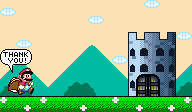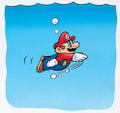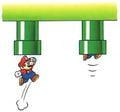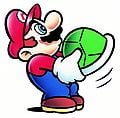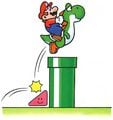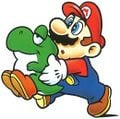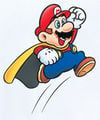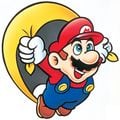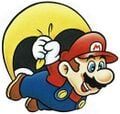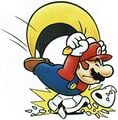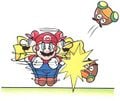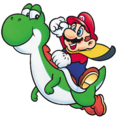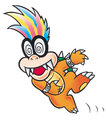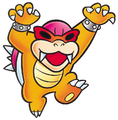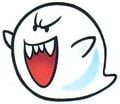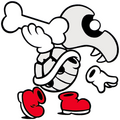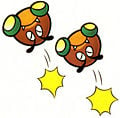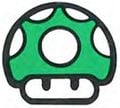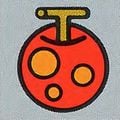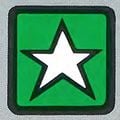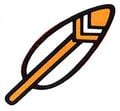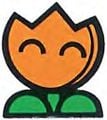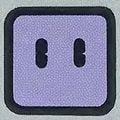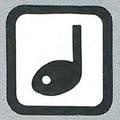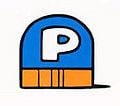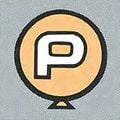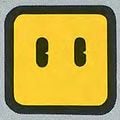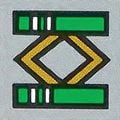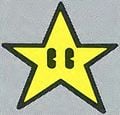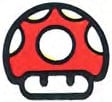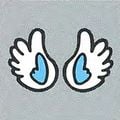Super Mario World: Difference between revisions
Dennyboy1997 (talk | contribs) (→Bosses) |
|||
| Line 304: | Line 304: | ||
Image:LudwigKoopa2 SMB3.png|[[Ludwig von Koopa]] | Image:LudwigKoopa2 SMB3.png|[[Ludwig von Koopa]] | ||
Image:RoyKoopa2 SMB3.png|[[Roy Koopa]] | Image:RoyKoopa2 SMB3.png|[[Roy Koopa]] | ||
Image:WendyKoopa2 SMB3.png|[[Wendy Koopa]] | Image:WendyKoopa2 SMB3.png|[[Wendy O. Koopa]] | ||
Image:LarryKoopa2 SMB3.png|[[Larry Koopa]] | Image:LarryKoopa2 SMB3.png|[[Larry Koopa]] | ||
Image:BowserSMW.jpg|[[Bowser]] | Image:BowserSMW.jpg|[[Bowser]] | ||
Revision as of 08:32, May 7, 2010
- For other information, also see the Super Mario World Game Watch.
Super Mario World (originally known in Japan as Super Mario Bros. 4: Super Mario World) was the first Mario launch game for the Super Nintendo Entertainment System, November 21, 1990. The game was produced by Shigeru Miyamoto, the music was composed by Koji Kondo, and the graphics were designed by Shigefumi Hino. This game was playable in the SNES and the Super Famicom. Super Mario World is an unlockable masterpiece in Super Smash Bros. Brawl. To unlock, one must play in the Yoshi's Island stage more than three times.
The game has a successor, Super Mario World 2: Yoshi's Island, which is set in the same place and plays similar to its predecessor. However, instead of taking place after Super Mario World, Yoshi's Island took place many years before it.
Story
Mario and Princess Toadstool were going to Dinosaur Land by Hot Air Balloon. When Mario and Toadstool arrived Luigi was there waiting for them with a Cape. Luigi gave Mario a Feather and Mario turned into Cape Mario. Mario and Luigi flew around Dinosaur Land with their capes.
Meanwhile, Bowser and his Koopalings trapped Yoshi's friends in eggs, and stole Princess Toadstool. When Mario and Luigi returned they found the princess missing. Mario and Luigi set out to save the princess with the help of the Yoshis and Dolphins.
Mario and Luigi start their mission to save the princess in Yoshi's Island. The brothers travel to the Yellow Switch Palace to activate all yellow ! Blocks. Here they rescue many trapped Yoshis, fight the first Koopaling, Iggy Koopa, and get the first Baby Yoshi. The Mario Brothers next go to Donut Plains, a place where there's a giant lake in the center of the place. The Green Switch Palace was here. The brothers also defeated Morton Koopa Jr. here.
The brothers then went to the cave, Vanilla Dome, a cave full of Swoopers, Buzzy Beetles and many more dangerous enemies. Lava was all around this cave and the Red Switch Palace is located here. The brothers also defeated Lemmy Koopa. Later in the Twin Bridges, the Mario brothers crossed a bridge (the other bridge was optional) and defeated Ludwig Von Koopa. The bridges were above Soda Lake.
The Forest of Illusions, were very challenging and the brothers had to find the secret exits to get to Roy Koopa and his castle. The Blue Switch Palace was located here. In Chocolate Island, the brothers went through mountains and land of chocolate. They got to Wendy O. Koopa's castle, later went to the Sunken Ghost Ship, which turned out to be a crashed Airship, and went on to the final level.
They finally got to Valley of Bowser, a very dark place. The Mario Brothers reached Larry Koopa and his castle and beat larry who was a guard at Bowser's Castle fought Bowser and his Koopa Clown Car and saved Toadstool. With the seven Yoshi Eggs, Mario, Yoshi, the Princess and Luigi returned to Yoshi's House where the other Yoshis (Red, Blue and Yellow) waited for them. Everyone watched the Baby Yoshis hatch out of their eggs. After that, Mario, Luigi and the Princess had a wonderful vacation in Dinosaur Land.
Also, Mario and Luigi can go to the Star World and Special World. These two levels were "extra" zones, and were optional. The player did not actually need to complete these areas to beat the game and were added as a special challenge for players. The Star World however is very helpful for traveling around Dinosaur Land. After beating the Special World some things in Dinosaur Land change, enemies and the overworld map get a different, fall themed, look and some other elements in the levels change (this doesn't happen in the GBA version, but this bonus can be unlocked in another way.)
Items & Power-Ups
Super Mario World has several items and power-ups:
Power-Ups
Mushroom- Mario or Luigi can eat a Mushroom to become "super."
Fire Flower- With a fire flower, the Mario Bros. can shoot fireballs at enemies.
Cape Feather- Using this feather, the Mario Bros. can fly.
Star- With a Star, the Mario Bros. will become invincible for a couple of seconds.
Items
1-Up Mushroom — If Mario or Luigi collects one, they'll get a 1-Up.
3-Up Moon — If Mario or Luigi collects one of these, they both get three extra lives. These are very rare being the first at Yoshi's Island 1.
Key and Keyhole — If the Mario Bros. put a key in a keyhole, a secret level will be unlocked.
P-Balloon — Mario and Luigi fatten up and inflate like balloons when they touch this item, allowing them to float in all directions for a short length of time.
P-Switches — When the blue switch is pressed, blocks transform into coins and vice-versa, and some invisible blocks will be revealed. If the silver one is pressed, some enemies, such as Spinies, will transform into Silver Coins. After a short period of time, the changes made by either switch will revert to normal.
? Ball — An item that is required to successfully complete certain levels.
Worlds
- Yoshi's Island
- Donut Plains
- Vanilla Dome
- Twin Bridges
- Forest of Illusion
- Chocolate Island
- Valley of Bowser
Bonus Worlds
If Mario and/or Luigi accumulate 100 stars by touching the flag at the finish, they play a bonus game where they hit blocks. Eight random blocks travel around a block that already has a determined power-up. Power-ups include Super Mushrooms, Fire Flowers, and Stars. Mario/Luigi can only hit blocks while they are at the bottom, and hit blocks continue to travel around the center (while retaining the hit power-up). Once the last block is hit, the blocks stop traveling and 1-ups are awarded. The number of 3-in-a-row matches determines the number of 1-ups the player will receive (Up to a maximum of 8).
Enemies
Playable Characters
Mario (and Luigi, in 2-Player) are the main playable characters. However, they need some Yoshis to help them in many levels. If Mario loses a life, Luigi comes in play until he loses a life.
Colored Yoshis
In this game there are four colored Yoshis that help the Mario Bros. in many levels of the game:
- Green Yoshi, the original Yoshi.
- Blue Yoshi, a Yoshi that flies if it eats an object.
- Yellow Yoshi, a Yoshi that can pound on the ground, defeating enemies in its impact.
- Red Yoshi, a Yoshi that spits out enemies and objects as fire.
- Green Yoshi SMW.PNG
- Blue Yoshi SMW.PNG
- Yellow Yoshi SMW.PNG
- Red Yoshi SMW.PNG
Red, blue and yellow Yoshis are extremely rare in Dinosaur Land. They live in the Star World, a mysterious place on Dinosaur Land accessible with five Star Roads throughout the land.
Critical reception
The game was placed 16th in the 100th issue of Nintendo Power's "100 best Nintendo games of all time" in 1997.[1] The game placed 47th in the 200th Issue of GameInformer's "Top 200 Games of All Times". Template:Sectionstub
Beta elements
- Main article: Super Mario World/Beta elements
Glitches
- Main article: Super Mario World/Glitches
References to Other Games
- Super Mario Bros. 3 - The Sunken Ghost Ship was once an airship from this game. Also each Koopaling returns here.
- Super Mario Bros. 2- Several enemies from this game (Ninjis, Pidgits) appear, bringing them into the proper Mario Universe, as they were from a dream world in this game. Also, since Super Mario Bros. 2 was just a remake of Doki Doki Panic, this introduced them as proper Mario enemies as well.
References in Later Games
- Mario Paint - Many sounds and graphics from here appear in this game.
- Mario's Time Machine - Many sounds and graphics from here appear in this game.
- Mario is Missing! - Many sounds and graphics from here appear in this game.
- Super Mario World 2: Yoshi's Island - This game is a prequel to Super Mario World, though the stories are practically unrelated in sharing some settings, and uses Yoshi as your main character, although you use one of nine Yoshies (or ten in the Game Boy Advance remake) for each stage for each zone.
- Super Mario RPG: Legend of the Seven Stars - The Star Road found here is destroyed by Exor and it is revealed that Geno is from here. Yoshi's Island also returns as Yo'ster Isle, and a rendition of the overworld music from this game plays upon first meeting Gaz.
- Super Mario 64 - The idea of Switch Palaces is, in a way carried over into this game, Yoshi also says that he and Mario haven't had an adventure together in ages, this was the last time they did.
- Super Smash Bros. Melee - There is a Super Mario World themed level, called Yoshi's Island, Banzai Bill returns, Mario can use his cape again, and trophies of the Koopa Clown Car and Mario riding Yoshi are collectible.
- Mario & Luigi: Superstar Saga - In a room in Woohoo Hooniversity, four blocks from previous games (the names of which are even stated in their descriptions) can be seen. One of them is the block from Super Mario World.
- Super Mario Sunshine - When FLUDD scans Mario, a video of Mario battling Iggy in this game can be seen.
- Super Smash Bros. Brawl - A short demo of Super Mario World is playable, and the Yoshi's Island returns. Bowser uses his Koopa Clown Car in the subspace emissary.
- Mario Roulette - Many sounds and graphics from here appear in this game.
- Super Mario Kart - Lakitu is near identical in appearance in this game, and many tracks in this game are based on levels here.
- New Super Mario Bros. Wii - Yoshi reappears in this game, behaving exactly as he did in Super Mario World. The Spin Jump also makes a return.
Changes when the 96 levels are Completed
After the Player beats this game, the following changes occur:
- World backgrounds change.
- Koopas transform into a big headed version of Mario and Luigi.
- Red Koopa Troopas are replaced with Blue Masked Koopas, while Green Koopa Troopas are replaced with Yellow Masked Koopas. This doesn't apply to Koopa Paratroopas though.
- Piranha Plants will change into Pumpkin Plants.
- Jumping Piranha Plants will turn into Jumping Pumpkin Plants.
- Bullet Bills are replaced with Pidgits.
- Goombas turn into a yellowish color and have sunglasses. (GBA version only)
- Pokeys turn into ravioli-like creatures. (GBA version only)
Trivia
- While the game was originally known as Super Mario Bros. 4, Shigeru Miyamoto has said that it ended up being an entirely new game.
- This is the first game where Power-ups were a web, instead of a chain like in the past games.
- According to Shigeru Miyamoto, sixteen people were involved in the creation of the game, and it took about three years to make.[2]
- If Luigi finishes beating a boss, the game will still say Mario had done it.
- The beta version of the game contained many elements from Super Mario Bros. 3, including the Super Leaf power-up which would allow the player to transform into Raccoon Mario and/or Raccoon Luigi.
- In Paper Mario, the player can enter a certain house in Koopa Village and they will see a radio. Walking up to it and pressing A will make it play the credits theme for Super Mario World.
- In the Japanese version, the enemy cast call was entirely in English. There were some mistakes made, however, such as erroneously calling Kuribon "Kuribo", Teresa "Telesa", Teresaur "Telesaul" and Mecha Koopa "Mekka Koopa". The Propeller Packun was also shortened to "P-Pakkun". Also, the post-Special Zone enemies were not given separate names. Some enemies are also not in the cast call (Pukupuku, Packun Flower, Black Packun, Kamek and Hakkun). In the overseas releases, all the names were Americanized to fit previous naming conventions, and the alternate enemies were given separate names. However, the missing enemies were never added.
- In this game, for the order that the Koopalings are fought in, Wendy and Lemmy are swapped from Super Mario Bros. 3 (as the third and sixth bosses), while Morton and Roy, alone of the seven, remain the same (second and fifth, respectively).
Staff
- Main article: Super Mario World/Staff
Media
Screenshots
- Title SMW.PNG
The Title Screen - YoshiLevel.PNG
- Donutplanicies.PNG
- Boss Norton.PNG
Morton Koopa Jr. Boss Battle - SMWend.jpg
The end of the game
Character Artwork
Protagonists
- Mariopaintart1.PNG
- SMW Fire Mario.jpg
Mario's Moves
- SMW Mario running.jpg
Mario running
- SMW Mario Boxing.jpg
Mario boxing
Mario going down a Warp Pipe
- TriBlSMW.jpg
Mario using a Triangular Block
Mario holding a Green Shell
- SMW Mario stealing a shell.jpg
Mario stealing a shell
- SMW Mario Shell Toss.jpg
Mario tossing a shell upwards
- SMW Mario Spin Door.jpg
Mario going through a Spin Door
Yoshis
- SMWYoshi.jpg
- YoshiBerrySMW.jpg
Yoshi eating a Berry
- SMW Yoshi Flame Breath.jpg
Yoshi breathing fire
- SMW Yoshi Flying.jpg
Yoshi flying
- SMW Yoshi stomping.jpg
Yoshi doing a Ground Pound
- SMW Blue Baby Yoshi.jpg
Blue Baby Yoshi
- SMW Red Baby Yoshi.jpg
Red Baby Yoshi
- SMW Yellow Baby Yoshi.jpg
Yellow Baby Yoshi
Cape Mario
- SMW Cape Mario running.jpg
Cape Mario running
- SMW Cape Mario flying.jpg
Cape Mario flying
- SMW Cape Mario nosediving.jpg
Cape Mario nosediving
Cape Mario Spin Jumping
Bosses
- BowserSMW.jpg
Enemies
- SMW Boo Buddies.jpg
- SMW Bob omb.jpg
- SMW Chargin Chuck.jpg
- DinoRhino.jpg
- DinoTorch.jpg
- SMW Jumping Piranha Plant.jpg
- Magikoopa.jpg
- MontyMoleArt.jpg
- SMW Rexes.jpg
- SMW Rip van Fish.jpg
- Sumo Bros..jpg
- SMW Urchin.jpg
- Wiggler1.jpg
Item Artwork
- SMW 3-Up Moon.jpg
- SMW Info Block.jpg
Scene Artwork
- SmwYoshi's Island.PNG
- Donut Plains2.jpg
- SMW Forest of illusion scene art.PNG
- Chocolate Island.jpg
- LudwigCastleArt.png
- RoyCastleArt.png
References
- ^ http://www.gamekult.com/communaute/forum/voirmessage.html?foid=13000909, retrieved 6/4/2009
- ^ Interview with Shigeru Miyamoto in Mario Mania Player's Guide, p. 32.
Speed-Run
